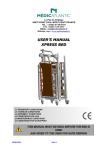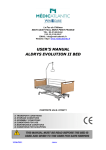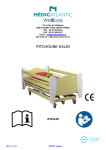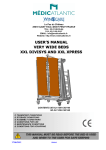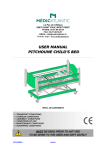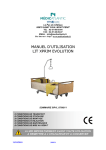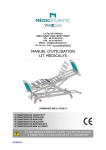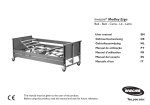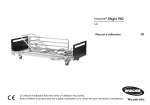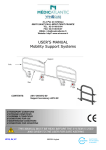Download USER'S MANUAL XPRIM EVOLUTION BED
Transcript
Le Pas du Château 85670 SAINT PAUL MONT PENIT FRANCE TEL.: 02-51-98-55-64 FAX: 02-51-98-59-07 EMAIL: [email protected] Website: http//: www.medicatlantic.fr USER’S MANUAL XPRIM EVOLUTION BED CONTENTS IXP2L 07/08/11 TRANSPORT CONDITIONS STORAGE CONDITIONS ASSEMBLY CONDITIONS CONDITIONS FOR USE MAINTENANCE CONDITIONS CONDITIONS FOR SCRAPPING 15/06/2011 580032 IXP2L 07/08/11 MEDICATLANTIC TRANSPORT CONDITIONS WARNING: When handling the bed base, the back and leg rests must be strapped to the bed frame. During transportation, the bed must be in low position, braked, strapped and protected by cardboard packing. The wired handset and supply lead should be attached to the bed base cross member. The head and footboards are protected by cardboard and strapped to the sleeping surface. The bed should be transported upright when in its original packaging in compliance with the instructions printed on the packaging (Top, Bottom, Fragile) or flat in certain circumstances (low height). In this case, the package must not be stacked. Packaging dimensions standing: L 930. W = 510. H = 2030. Packaging dimensions flat: L 2030. W = 930. H = 510. It is strictly forbidden to stack packages weighing over 60kg/m², whatever position they are in. Before transporting or dismantling the bed, make sure the back and leg rests are fixed to the frame of the bed base. STORAGE CONDITIONS The bed, along with the boards and accessories, must be stored at a room temperature of between -10°C and +50°C, and relative humidity of between 30% and 75%. Atmospheric pressure between 700hPa and 1060hPa under the same conditions as for transporting. ASSEMBLY CONDITIONS INSTALLATION RECOMMENDATIONS: This equipment should be installed in accordance with the following recommendations: Check that the equipment functions properly (test all of its functions) after it has been installed. Users must be trained in how to use the equipment. Users (the patient and carers) must be aware of the safety instructions to be followed (see user’s manual). 15/06/2011 - 2 / 24 - IXP2L 07/08/11 MEDICATLANTIC 3.1 SETUP FOR USE Remove the packaging protective devices, adhesive tape and packing straps. Fit the head and footboards with weights into the ends of the bed base and fix them using the Rondo screws in the corners of the bed base. Hook the wired handset onto the headboard by passing the cord over the cross braces as in the photo below to stop them getting caught. Put the bed in the designated room, foreseeing an appropriate perimeter of use for the different functions (variable height), especially if the bed has a lifting pole or side rails. Brake the castors and plug in the power lead, checking that the mains comply with the standards in force and that it is suitable for the supply box voltage. Also ensure that the power lead is positioned correctly to prevent any risks of getting caught between the moving parts of the bed. See photo below. Clip to secure the power lead 3.2 DISMANTLING/ASSEMBLING THE BED (for divisible bed base) Braking The brake on the 4 castors must be locked when the bed does not need to be moved. Check that the wheels are locked by trying to move the bed. If this is not done, the patient or another person who leans on the bed may fall. A A. Braking: press down on the brake with your foot. B. Releasing the brake: press down on the release lever with your foot. 15/06/2011 - 3 / 24 - B IXP2L 07/08/11 MEDICATLANTIC Centralised braking (optional) C A. Braked wheels: push the pedal (red side) with your foot. A B. Wheels released: push the pedal (A or C) with your foot to get to the middle position. C. Steering castor: push the pedal (green side) with your foot Before transporting or dismantling the bed, make sure the back and leg rests are fixed to the frame of the bed base. Dismantling the bed 1. Dismantle the accessories: side rails, boards and lifting pole. 2. Brake the wheels and position the bed in its lowest position + 10 cm approx. 3. For the electric leg rest version: disconnect the motor lead (lift clip using a screwdriver to release the jackwire) (A). 4. Slightly loosen the Rondo screws, dismantle the clip pin between the two ½ bed bases, pull the foot-half bed base towards the foot and push it under the head-half bed base (B, C). 5. Put the bed in its lowest position. 6. Disconnect the electric lead from the variable height motor. 7. Take out the pins connecting the bed base/cross brace and remove the frame of the half bed base (D). 8. The base is ready to be moved or transported. A. B. Rondo screws Clip D. C. 15/06/2011 - 4 / 24 - IXP2L 07/08/11 MEDICATLANTIC Assembling the X Prim Evolution bed 1. Place the base with the cross brace in the braked position. 2. Position the head-half of the bed base on the cross brace using the 2 pins : assemble (if dismantled) the jack, power leads and remote control on the bed base and back rest. Take out the power lead under the head-end cross brace, clip it into the plastic part under the bed base and plug it into the mains. 3. Take out the electric lead(s) of the motors under the 2 cross members of the cross braces and connect it (them) on to the variable height jack. 4. Raise the variable height of the bed by around 10cm. 5. Connect the foot-half of the bed base in the slide rails and put it under the head-half of the bed base (F). 6. Assemble the two ½ bed bases and put the clip pin between the two ½ bed bases. Tighten the 2 Rondo screws . 7. Plug in the electric lead of the leg rest motor on the electric version (A). 8. Assemble the accessories: boards, side rails and lifting pole. Before using, check that the Rondo screws are well tightened, that the clip pin is firmly in place between the two half bed bases and that the half bed bases are positioned properly. E. F. F. Passing the motor leads 3.3 LIST OF ACCESSORIES Item Reference Working load safety Lifting pole A 1600 / A 9300 A 243-00 / A576-00 A 579-00 / A580-00 A 603-00 / A 604-00 A 605-00 / A 606-00 A 578-00 A 17 00 A 84 00 A 283-00 A 293-00 A 575-00 75 Kg Full length wooden side rails Vision epoxy folding rails Vision chromed folding rails Xprim Evolution wall stop IV stand Telescopic IV stand Bed base extension* Xprim Evolution skirt Handle support Not applicable Not applicable Not applicable Not applicable 8 Kg 8 Kg Not applicable Not applicable Not applicable *not available with full length wooden side rails Only accessories and boards supplied by MEDICATLANTIC guarantee safe use. 15/06/2011 - 5 / 24 - IXP2L 07/08/11 MEDICATLANTIC Compatibility of the mattress : Products Features compatible mattresses XPrim Evolution Bed Minimum width 86 cm, high resilient foam with a density of 34kg / m³ IXP2L minimum, height 14cm mini and 15 to 17cm maxi Incompatibles mattresses may create HAZARDS 3.4 SETTING UP THE ACCESSORIES Angled lifting pole The lifting pole is intended to help the patient lift him/herself up and change position in the bed. It is not meant to help with transferring. Fit the angled lifting pole into the slots on each side of the head-end of the bed base until the tab is engaged. Wall stop without centralised braking Wall stop with centralised braking (optional) Folding side rail 1. Assemble the folding side rail in the direction shown by the photo 2. Leave a space of 3 to 4 cm maximum at the head of the bed. 3. Tighten the Rondo screws of the grip jaws on the bed base. 15/06/2011 - 6 / 24 - IXP2L 07/08/11 MEDICATLANTIC 3 to 4 cm HEAD end FOOT end Indexing pin If the side rail is poorly positioned, user safety may be endangered or a malfunctioning may occur. The side rails must not be used when the patient is a child or if s/he is too small. To lower the side rail. 1. Take the side rail by the top rail. 3 22 4 Pull on the locking button. To raise the side rail. 1. Take the side rail by the top rail and lift. Check that the side rail is locked by trying to fold it without using the release pin Precaution for use. There must be at least 220 mm between the top of the side rail and uncompressed mattress surface. 15/06/2011 - 7 / 24 - IXP2L 07/08/11 MEDICATLANTIC Full lenght wooden side rails To raise the side rail. Lift the top rail with two hands until it locks. Check if it is well under way. To lower the side rail. Lift the top rail with one hand. Press the indexing pin with the other hand. Accompany the descent of the side rail. Repeat steps to to the other side 15/06/2011 - 8 / 24 - IXP2L 07/08/11 MEDICATLANTIC 3.5 INSTRUCTIONS FOR DISMANTLING THE MOTORS Disconnect the 230 volts connection before dismantling. • • • • Dismantle when the bed is empty or in the side position If dismantling in any other position, keep a firm hold of the moving parts to avoid any shearing. Unplug the motor leads, unblock the motor clips and remove them from the securing seals. Put the motors back in place and put in the same direction as at the beginning. Clip 3.6 FLATTENING THE BACK REST ON THE BED In the event of a power cut or failure, flatten the back rest as follows: a) Disconnect the power supply. b) Dismantle the headboard and wooden side rail if necessary. c) Stand at the head of the bed and take hold of the back rest handle with one hand. Push or lift to compensate the pressure exerted by the patient and unhook the clip by the connecting rod with the other hand. The back rest jack will then pivot downwards. d) Put the headboard back. 2 3 5 1 4 To exchange the jack: unplug the electric lead from the motor and remove clips and . 15/06/2011 - 9 / 24 - IXP2L 07/08/11 MEDICATLANTIC Emergency flattening of the back rest (optional) (can be used in the event of a power cut): Activate one of the two handles on the back rest while lowering the back rest with the other hand. If the handle is released, the back rest will stop moving. Clutch release handle ELECTRICAL CONNECTION DIAGRAM Button for manual leg rest version or leg rest jack for electric version Back rest jack Variable height jack Remote control 1 15/06/2011 2 3 4 - 10 / 24 - HB IXP2L 07/08/11 MEDICATLANTIC - The bed must be plugged into a dedicated socket. When use of an adaptor, extension lead or connection plug proves necessary, you must check that its characteristics are suitable for the bed. - The cleaning instructions recommended must be complied with. - The mains plug must be disconnected before the bed is moved. When the bed is being moved, the lead must not trail on the ground or get caught in the castors. -‐Do not pull on the mains leads to disconnect the mains plug. -‐ During any handling, try not to catch the leads of the motors and remote control and do not get them knotted. -‐ The condition of the leads must be checked frequently. If the slightest modification is observed, the person in charge for maintaining the bed must be contacted to carry out the necessary repairs. -‐ If repairs are required, the person in charge of maintenance must be contacted. Moreover, the telephone number of the company to be contacted for any repairs is given in this document. 4.1 PURPOSE OF BED The beds are not designed for children under 12, or for any other purpose apart from those stipulated below. Depending on their configuration, the beds are intended for home use (HAD – MAD), EPHAD and HPA. The beds with the emergency flattening option of the back rest are designed for medical care centres. 15/06/2011 - 11 / 24 - IXP2L 07/08/11 MEDICATLANTIC 4.2 GENERAL DESCRIPTION This bed has a headboard and footboard. See the types of board on offer in the price list. Back rest handle Slatted back rest CPR handles Slatted leg rest Footboard Headboard Bed base Angled lifting pole slots Leg rest handle IV stand slots Castors Base and cross braces. Manual crank or electric folding leg rest depending on version. MEDICATLANTIC recommends the use of a patient lift or a dining table bases with less than 120 mm high. 15/06/2011 - 12 / 24 - IXP2L 07/08/11 MEDICATLANTIC 4.3 TECHNICAL CHARACTERISTICS Electrical characteristics Bed code Class II (double insulation) XXXXXXX Protection level against liquid penetration Voltage Current type Frequency Operating time Protection level against electric shocks (type B) Absorbed power Electrical data PROTECTION INDEX LA 27 6000N IP 66 LA 27 6000N LA27 IP 66 3500 N TYPE Variable height jack Back rest jack CPR jack (optional) Leg rest jack VOLTAGE FREQUENCY 24V DC 24V DC LA 27 6000N IP 66 24V DC Supply box CB 6 IP 66 230 V AC Unlockable wired handset HB72/HB74 IP 66 24V DC Lockable wired handset HL72/HL74 IP 54 24V DC 50 HZ Operating time: 2 minutes of continuous use followed by 18 minutes down time. The type and gauge of mains fuse F=(1AT) . Weight • Normal load in use: 170 kg (Patient 135 kg, Mattress 20kg. Accessories 15kg) Bed, version electric folding leg rest (without boards)……………………………..………... 68 kg Bed, version manual crank leg rest (without boards)……………………………………...… 64 kg Base…………………………………………………………………………………………… 29.5 kg Head-end bed base………………………………………………………………..………… 0.21 kg Foot-end bed base, version electric folding leg rest……….…………………..………… 23.5 kg Foot-end bed base, version manual crank leg rest…..…………………………..……… 19.5 kg 15/06/2011 - 13 / 24 - IXP2L 07/08/11 MEDICATLANTIC Dimensions Castor with Ø 100 Equipotentiality socket Under the head-half of the bed base you will find an equipotentiality socket , identified by the label , enabling you to connect any electromedical devices. The leads of these devices must pass through the head end and not the sides. Equipotentiality Label 15/06/2011 - 14 / 24 - IXP2L 07/08/11 MEDICATLANTIC 4.4 USE - Carry out a test cycle when the bed is empty to familiarise yourself with the bed functions. Version with electric folding leg rest Version with manual leg rest Lifting and lowering of back rest Lifting and lowering of variable height Lifting and lowering of electric folding Simultaneous lowering and lifting of back rest and folding Key to lock a function (optional) TURN THE KEY SLIGHTLY TO THE RIGHT TO LOCK THE FUNCTION KEY IN VERTICAL POSITION: THE FUNCTION IS UNLOCKED 15/06/2011 - 15 / 24 - IXP2L 07/08/11 MEDICATLANTIC Cranks To lift, lift the leg rest or the folding (depending on model) using the wire handle at the end. To lower, lightly relieve the leg rest with one hand to release the catch and lower the leg rest. 4.6 PRECAUTIONS FOR USE Before use, it is essential to read these instructions carefully. They contain advice on using and looking after the bed to guarantee optimum safety. The user and staff must be aware of the risks associated with using the bed and children must not be allowed on it. Although the bed is EMC conforming, some devices may alter how it functions, in which case they must be used at a distance or not used at all. The bed is a medical device and must not be modified under any circumstances. You must ensure its traceability, including that of the boards and its accessories. If you assemble different types of medical devices, you must conduct a risk analysis and make the CE declaration. The electric parts (jack, supply box, wired handset, etc) shall only be repaired by the manufacturer Linak. The bed is not suitable for use with an inflammable anaesthetic mixture with air or oxygen or nitrous oxide. After each use and while care is being administered to the patient, the 4 brakes must be activated to secure the bed. The loads permitted (see bed characteristics) must be distributed evenly over the bed base and include the weight of the boards, mattress and different accessories. Do not activate all the motors at the same time when the patient is in the bed (only one motor is authorised at one time). After each time the bed is used and when the patient is resting, it must be placed in low position to protect the patient from injury (if the patient’s health requires this: confused, demented or physically weak). Do not forget to lock the wired handset (optional). For greater safety, the side rails can be adapted (see accessories). Do not sit on the side of the back rest or leg rest if it’s not flat. The bed should not be used as a stretcher. When the bed is placed in low position, make sure that there are no objects and no parts of the patient’s or carer’s body caught between the boards and the ground, between the boards and base or between the cross braces. When the bed is being moved, keep the power lead well away from the ground and castors. Powering up Connection to the supply box must be done using a mains complying with the standards in force and corresponding to a voltage of use of 230 V. The wired handset must be hooked to the headboard when not in use. 15/06/2011 - 16 / 24 - IXP2L 07/08/11 MEDICATLANTIC During handling, the spiral lead and/or power lead should be kept away from moving parts such as the cross brace or back rest and should not be knotted. Only use original parts and accessories supplied by MEDICATLANTIC to guarantee safety and maintain product conformity. The bed must not be modified. Abnormal use of the bed may damage it or cause accidents to users, in which case the warranty shall be annulled. Abnormal use means failure to comply with the precautions for use, maintenance instructions and other uses not related to the bed’s normal purpose, such as: use of the bed by several people at the same time, use outdoors, moving the bed on a slope that is steeper than 10°, etc. Manufacturer’s declaration and guide –electromagnetic emissions The medical bed (see references in contents) has been designed for use in the electromagnetic environment specified below. The user should ensure that it is used in such an environment Emissions test Compliance RF emissions Electromagnetic environment - Guide Group 1 The medical bed (see references in contents) uses RF energy only for its internal functions. Therefore, its RF emissions are very low and are not likely to cause any interference in nearby electronic equipment. Class B The medical bed (see references in contents) can be used in all domestic environments, including those directly connected to the public low-voltage power supply network that supplies buildings for domestic purpose. Class A [] CISPR 11 RF emissions CISPR 11 Harmonic emissions EN 61000-3-2 Voltage fluctuations / Flicker Applicable EN 61000-3-3 RF emissions Compliant The medical bed (see references in contents) has not been designed for connection to other equipment. CISPR 14-1 Manufacturer’s declaration and guide –electromagnetic immunity The medical bed (see references in contents) has been designed for use in the electromagnetic environment specified below. The user should ensure that it is used in such an environment CEI 60601 Immunity test Electrostatic discharge ± 6 kV contact EN 61000-4-2 ± 8 kV air Electrical fast transients ± 2 kV for feeders EN 61000-4-4 Surges EN 61000-4-5 Compliance level Electromagnetic environment - Guide L Severity level ± 6 kV contact ± 8 kV air Floors should be wood, concrete, or ceramic tile. If floors are covered with synthetic material, the relative humidity should be at least 30 %. ± 2 kV for feeders ±1 kV for input/output lines The quality of the main power supply must be the same as for a typical commercial or hospital environment. Differential mode ± 1 kV Differential model ± 1 kV The quality of the main power supply must be the same as for a typical commercial or hospital environment. Common mode ± 2 kV / ± 1 kV for input/output lines Voltage dips, short interruptions and voltage variations • <5% UT - for 10 ms • <5% UT – for 10 ms • 40% UT - for 100 ms • 40% UT - for 100 ms EN 61000-4-11 • 70% UT - for 500 ms • 70% UT - for 500 ms • <5% UT - for 5 s • <5% UT - for 5 s Power frequency magnetic field (50/60 Hz) 3 A/m 3 A/m The quality of the main power supply must be the same as for a typical commercial or hospital environment. If the user of the medical bed (see references in contents) wants to be able to continue to use the bed during interruptions in the main power supply, it is recommended that the bed be powered by a converter or battery. Power frequency magnetic fields should be at levels characteristic of a typical location in a typical commercial or hospital environment. NB: UT is the nominal value of power voltage applied during the test. Manufacturer’s declaration and guide –electromagnetic immunity The medical bed (see references in contents) has been designed for use in the electromagnetic environment specified below. The user should ensure that it is used in such an environment 15/06/2011 - 17 / 24 - IXP2L 07/08/11 CEI 60601 Immunity test MEDICATLANTIC Compliance level Electromagnetic environment - Guide Severity level Portable and mobile RF communications equipment should be used no closer to the medical bed (see references in contents), including leads, than the recommended separation distance, calculated using equations applicable to the frequency of the transmitter. Recommended separation distance Conducted RF 3 Vrms EN 61000-4-6 150 kHz to 80 MHz Radiated RF 3 V/m EN 61000-4-3 80 MHz to 2.5 GHz 3V d = 1,17 P 3 V/m 80 to 800 MHz d = 1,17 P 80 MHz to 800 MHz d = 2,33 P 800 MHz to 2.5 GHz 2 to 2.5 GHz 10 V/m 800 MHz to 2 GHz P where is the maximum output power rating of the transmitter in watts (W) according to the transmitter manufacturer and d the recommended separation distance in metres (m). The field strengths transmitted by fixed RF transmitters, determined by an electromagnetic a measurement of the site , must be less than the conformity level in each range of frequencies. Disturbances can occur near devices marked with this symbol: Note 1 At 80 MHz and 800 MHz, the upper frequency range applies. Note 2 These guidelines may not apply in all situations. Electromagnetic propagation is affected by absorption and reflection from structures, objects and people. A Field strengths from fixed transmitters, such as base stations for radio (cellular/cordless) telephones and land mobile radios, amateur radio, AM and FM radio broadcast and TV broadcast cannot be predicted theoretically with accuracy. To assess the electromagnetic environment due to fixed RF transmitters, an electromagnetic site survey should be considered. If the measured field strength in the location in which the medical bed (see references in contents) is used exceeds the applicable RF compliance level above, the AccuGuide® Monitor should be observed to verify normal operation. If abnormal performance is observed, additional measures may be necessary, such as re-orienting or relocating the medical bed. B Over the frequency range 150 kHz to 80 MHz, field strengths should be less than 3 V/m Recommended separation distances between portable and mobile RF communications equipment and the medical bed (see references in contents) The medical bed (see references in contents) is intended for use in the electromagnetic environment in which radiated RF disturbances are controlled. The customer or the user of the bed can help prevent electromagnetic interference by maintaining a minimum distance between portable and mobile RF communications equipment (transmitters) and the bed as recommended below, according to the maximum output power of the communications equipment. Separation distance according to frequency of transmitter m Rated maximum power of transmitter 150 kHz to 80 MHz 80 MHz to 800 MHz 800 MHz to 2.5 GHz d = 1,17 P d = 1,17 P d = 2,33 P 0,01 0,12 / 0,116 0,12 / 0,116 0,23 / 0,233 0,1 0,37 / 0,316 0,37 / 0,366 0,74 / 0,736 1 1,17 / 1,16 1,17 / 1,16 2,33 / 2,33 W 10 3,70 / 3,66 3,70 / 3,66 7,37 / 7,36 100 11,70 / 11,6 11,70 / 11,6 23,30 / 23,3 For transmitters rated at a maximum output power not listed above, the recommended separation distance d in meters (m) can be estimated using the equation applicable to the frequency of the transmitter, where P is the maximum output power rating of the transmitter in watts (W) according to the transmitter manufacturer. Note 1 At 80 MHz and 800 MHz, the separation distance for the higher frequency range applies. Note 2 These guidelines may not apply in all situations. Electromagnetic propagation is affected by absorption and reflection from structures, objects and people. MAINTENANCE CONDITIONS The quality of the medical beds will be inspected: -by trained technical or biomedical staff; 15/06/2011 - 18 / 24 - IXP2L 07/08/11 MEDICATLANTIC -by taking account of the normal conditions for use specified in the user’s manual on a bed equipped with specific safety rails. The bed must be available for carrying out a full quality inspection at least once a year, but also: -on specific request -after curative maintenance on performances which could have been affected by the repairs. However, to save time, this may be carried out at the same time as preventive maintenance. In this case, it is not worth carrying out a new inspection of performances that have already been checked. With external test devices to the medical bed, compatible with the performances claimed; -by referring to the user’s manual if necessary. 5.1 MAINTENANCE RECOMMENDATIONS FOR PREVENTIVE MAINTENANCE: Preventive maintenance should be carried out in accordance with our specifications and at least once a year by the organisation or person who installed the bed. Between two maintenance sessions and at least once a year, the following should be carried out: - Verification that the electrical leads are connected all along the metal jambs to prevent shearing of these leads when the variable height is being activated. - Verification that all of the electrical leads and plugs are in good condition. Replacement if there is the slightest alteration (wear, shearing, damage, etc.). - Verification of the external appearance (traces of damp and good overall condition of protective covers in particular) and that the motors and jacks function properly. - Verification that the bed is in good working order (test all functions). - Verification that the frame, bed base and mechanical joints are all in good condition. When maintenance is carried out at the patient’s home as part of a long-term contract, the installer must also: - Check the bed is properly installed (check to see that there hasn’t been any modification contrary to the safety instructions made by the user since the bed’s installation). - Remind the users of the safety instructions. - All installation and preventive maintenance operations must be recorded. See table model below. This record must be kept in a designated area throughout the bed’s lifetime. 15/06/2011 - 19 / 24 - IXP2L 07/08/11 MEDICATLANTIC QUALITY INSPECTION OF MEDICAL BEDS IDENTIFICATION OF MEDICAL BED CATEGORY TYPE MODEL TRADEMARK ESTABLISHMENT SERIAL NO. INVENTORY NO. DATE OF MANUFACTURE SERVICE SITE TEST DEVICES CHECKED AND CONFORMING WITH STANDARDS Description Type/model Identification/serial no. Mass continuity tester Dielectrimeter Fault current to patient Qualitative aspects NA (1) YES NO NA (1) YES NO VISUAL CHECKS General condition User’s manual available Headboard and footboard present Good overall condition (head and footboards, bed corners, protective stops) General cleanliness Acceptable state of corrosion given the requirements of the user Identification/label/serigraphy in good condition Mechanical condition Lifting pole in good condition (positioning and strap) Mechanical leads in good condition Sleeping surface in good condition (bed base) Boards lock and tighten well (head and footboards) Chest rest functions properly Leg rest functions properly Half-seated position functions properly Manual leg rest functions properly TR/RTR positions function properly Bed base extension functions properly Castors function properly (pivoting, rolling, etc.) including the steering castor where applicable. Bed immobilises properly (castor brakes, etc.) Verification of tightenings, diverse nuts and bolts, pins, pivot, IV stand Qualitative aspects Verification that welds are in good condition 15/06/2011 - 20 / 24 - IXP2L 07/08/11 MEDICATLANTIC Absence of sound disturbances (squeaking, lubrications) Electrics, hydraulics and pneumatics Electrical leads, plugs and connectors are in good condition (not sheared, not caught, etc.) Electrical parts in good condition (leads, motors, boxes, etc.) Hydraulic and pneumatic parts in good condition (pumps, compressors, jacks, dampers, etc.) Remote controls, displays and lights in good condition Bed-specific side rails NA (1) YES NO NA (1) YES NO NA (1) YES NO The rails in place and specific to the bed and/or comply with the manufacturer’s specifications Properly positioned and secured Side rail locking functions properly in raised position Check that the height measured from the top of the barrier to the uncompressed mattress surface, excluding therapeutic mattresses, is more than or equal to 220 mm (complies with the standard in force) 2 Safety check Locking of operational functions Inactivation of variable height control pedals Cardio Pulmonary Check that the headboard extracts or Resuscitation (CPR) retracts properly in an emergency emergency flattening of the Check that the chest rest emergency back rest flattening function works properly Withstands jack load well Visual and sound alarms in good working order Quantitative aspects Bed functions properly using the battery Check the scale of movements Maximum angle when propped = Maximum angle of specifications claimed by the manufacturer (± 2°) Maximum height = Maximum height of specifications claimed by the manufacturer (± 20 mm) Minimum height =Minimum height of specifications claimed by the manufacturer (± 20 mm) Electrical safety Electrical safety inspection (Values comply with EN 60601-1) Comments 15/06/2011 - 21 / 24 - IXP2L 07/08/11 MEDICATLANTIC Conclusion Operational (is the safety of the patient, carers and technical staff at risk?) YES NO Plan of action (see comments) 3 Recommended date of next quality inspection NAME OPERATOR Establishment DATE Signature 1 Not Applicable 2 If the height measured does not comply with the standard, the health manager responsible for correct application must be informed. Failure to comply is not a criterion for a non operational status. 3 The manager decides on the actions to take and which people to contact depending on the results of the quality inspection and the comments made. 5.2 CLEANING AND DISINFECTION Pressure cleaning is forbidden. Unplug the mains lead. Check that all the electrical parts are connected together. All the sockets of the supply box must be used, otherwise the watertightness of it is not guaranteed. Clean the electric covers of the jacks and wired handset straightaway if any bodily fluids, particularly urine, have sprayed on to them. Isolate the medical bed in a disinfection room equipped with a particle filtering system and drain for washing floors and walls after disinfection. How to use the WIP’ANIOS cloth Carefully wipe the surface to be treated and use a second cloth if the surface is very dirty. The surface only needs rinsing in the event of: subsequent contact with mucous membranes, possible contact with unwrapped foodstuffs. 15/06/2011 - 22 / 24 - IXP2L 07/08/11 MEDICATLANTIC Qualitative compositions The impregnation solution of the WIP’ANIOS cloths contains: .Didecyldimethylammonium chloride, .Isopropanol,(8%p/p), .Fatty alcohol ethoxylate type detergent. Physicochemical properties Impregnation solutions of cloths 5ml per cloth. Size 200 mm x 200 mm Microbiological properties The impregnation solutions of the cloths have a microbial effectiveness -Bactericide NF EN 1040 -Bactericide in the presence of interfering substances NF EN 1276 pr EN 13713. -Bactericide in carrier method: NF T 72190 (spectrum 4). -Active on Mycobacterium tuberculosis (BK). -Active on Candida albicans: NF EN 1275. -Fungicide in the presence of proteins: NF EN 1650 -Active on herpes virus and Rota virus Leave to dry and protect the equipment from being contaminated by other non-disinfected equipment with a film labelled with the date of disinfection. Product for external use. Do not swallow, keep away from heat sources and avoid contact with eyes 5.4 WARRANTIES All of our products carry a warranty against any manufacturing defect, provided the normal conditions for use and maintenance are complied with. Labour costs due to changes in structures or parts under warranty are not taken into account. Please refer to the standard terms of sale for the specific terms of warranty for each product. Every time you contact us for possible maintenance, you must quote us the information on the bed identification label and on the electric parts if these are concerned. Original parts shall be supplied for replacement, within the term of warranty, by our customer sales network determining the beginning of the term of warranty. Defective parts must be returned to ensure proper application of this warranty and also to avoid any invoicing. 15/06/2011 - 23 / 24 - IXP2L 07/08/11 MEDICATLANTIC 5.5 IDENTIFICATION Manufacturer Product identification CE marking Refer to user’s manual Serial number and date of manufacture Address Safe operational load Refer to user’s manual 5.6 LIFETIME The bed’s lifetime under normal conditions of use and maintenance is: 5 years CONDITIONS FOR SCRAPPING The product must be scrapped if the main requirements are no longer met, particularly when the product no longer has its original characteristics and has not been subject to corrective action during the manufacturing process. Measures should therefore be taken to ensure that the bed is no longer used for the purpose it was originally intended. When scrapping, the current environmental standards must be complied with. 15/06/2011 - 24 / 24 -
























